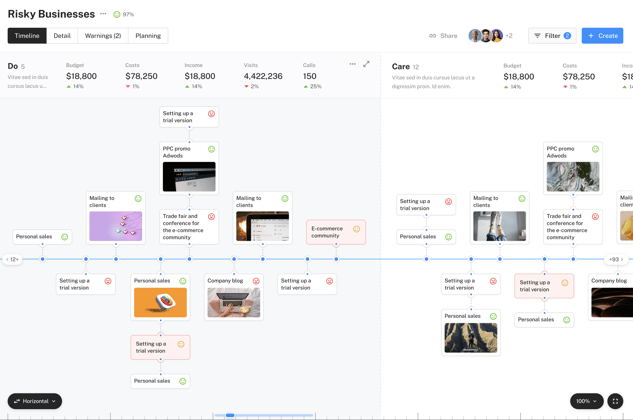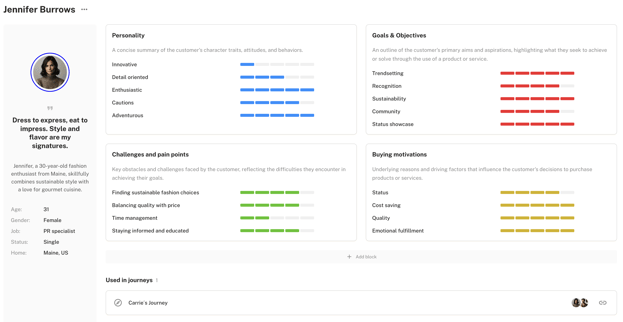Your first customer journey
The customer journey is a mindmap that helps you understand how customers interact with your company, product, or service. By analyzing the customer journey, you can identify pain points, optimize touchpoints, manage activities, and enhance customer satisfaction resulting in driving your business growth.
6 steps to powerful customer journey management
1. Think about your key customer audiences and define your customer personas
A customer persona is a representation of your customers, reflecting their needs, skills, fears, and motivations. It helps you understand your customers and create a personalized experience.
Tip: With Out of Dark, you can quickly create your personas in a few clicks by using a simple easy-to-use Persona editor.
2. Think about the phases of your customer journey
Phases represent the logical steps a customer goes through on their journey, including considering, deciding, buying, using, or seeking support. We suggest kicking things off with a tried-and-tested strategy: Awareness, Consideration, Purchase, and Loyalty.
- Awareness: This is the initial phase of the customer journey. At this point, potential customers become aware of your brand or product. They might have encountered your business through advertising, social media, or other channels.
- Consideration: In this phase, customers are considering their options. They are actively researching and evaluating different products or solutions. Your marketing content should focus on educating and helping customers make informed decisions.
- Purchase: The "Do" phase is where customers take action, such as making a purchase, signing up for a newsletter, or requesting more information. This is the conversion stage, and your marketing efforts should be designed to facilitate and encourage these actions.
- Loyalty: After the purchase, customers enter the "Care" phase. This is where you focus on customer retention and loyalty.
3. Design your journey layout
Think of your journey as a grid. The horizontal axis is for your Phases, like See, Think, Do, Care. For the rows, think about what you want to examine throughout the journey. A piece of advice - keep it simple. Too many rows can cause a lot of complexity and overwhelm you with information. Aim to select only the most crucial aspects to focus on.
One example of a simple, yet powerful journey map layout
| Awareness |
Consideration
|
Purchase |
Loyalty
|
|
|
Touchpoints and interactions
|
||||
|
Customer expectations
|
||||
|
Pain points
|
||||
|
KPI / Goals
|
||||
|
Opportunity to improve
|
Tip: Sounds difficult? Dont worry. Out of Dark offers several journey templates for free to help you with building your first journeys.
4. Map and analyze the journey from the customer’s point of view
Put yourself in your customer's shoes. Focus on your persona and think about how they move through each phase, what information they're looking for, and how they feel at every stage. Identify any pain points that could lead to frustration or cause them to drop out of the journey.
A few examples you may consider:
- Website - number of visits
- Newsletter - open rate of your regular newsletter
- Online marketing - revenue generated from PPC and display advertisement
- Store - convenience and level of service
- Social networks - number of followers on your social network accounts
- Customer support - customer satisfaction with support provided
- Customer reviews - average rating at Google, Facebook, Trustpilot, or other pages with your reviews

5. Measure your performance and set up your goals
What you measure is what you get. Define how you measure success across the journey. What are the metrics and what are the goals? A few examples - the number of website visits, conversion rate, customer reviews, and churn rate.
6. Drive improvements
The customer journey is not just a map. It’s a powerful business management tool as it reveals all the opportunities how to improve your business and relationship with customers. Make sure you assign the ownership and responsibilities to the right people and make regular follow-ups. Your business and customers will appreciate it.
Are you looking for a single, powerful, easy-to-use tool to help you with everything mentioned above? Well, look no further - introducing Out of Dark.
It is designed to be your ultimate tool for tracking and improving your customer journey. It combines the benefits of customer journey mapping, a live dashboard, and task management, all packed into a user-friendly tool.

